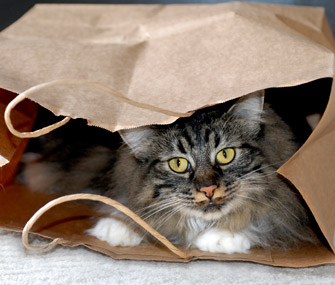Tips to Get Your Flabby Feline Moving
Published on September 23, 2015
Skip To

Our house cats are similar in some ways to these wild felines — though they generally watch the world from their favorite pillow. Just because cats don’t excel with long-distance exercise doesn’t mean we shouldn’t encourage them to get up and move — especially if they have pounds to lose! But because exercise is not second nature to cats, it often takes creative thinking to get our feline friends on the go.
Cats are designed for short bursts of activity, and any opportunities for your cat to stalk and pounce will provide both excellent exercise and mental stimulation. There are many kinds of cat toys available and many you can make yourself. Cats generally love toys that squeak, chirp or move in some manner.
If your veterinarian has advised you that your flabby feline could benefit from a little more activity, here are some helpful tips to get you started on the path to better health. Try these games and tricks to get your cat moving and, hopefully, losing (although be sure to consult with your veterinarian before embarking on any exercise program with your pet).
- Find the food. Gradually move your cat’s food bowl up or downstairs, so he must walk in order to get his food. If mobility problems keep him from being able to go up or down stairs safely, keeping his food bowl as far away from his favorite resting spots as possible will help accomplish the same goal (although be sure to consult your veterinarian first to make sure it’s obesity and not painful arthritis that is keeping him from getting up and moving around). This way he won’t wake up from a nap and take a bite out of boredom — he’ll have to walk a distance when the hunger pangs hit.
- Stalk and
pounce. Small, fast-moving objects appeal to most cats’ innate love of
chase. Many cats prefer realistic bird or mouse toys at the end of a string
pulled across the floor or dangling from a stick. Some cats will be perfectly
willing to chase small hollow balls or scrunched up pieces of newspaper thrown
across the floor. Try tying any small toy or feather from the end of a wand or
stick and see what your cat thinks.
- Boxing or bagging. Nothing spells joy for some cats more than an empty paper bag or cardboard box. They will dart in and out and climb on top. It may not seem like much, but some cats will play vigorously for long periods of time.
- Tag — your cat is it! Many cats experience pure pleasure from a rousing game of laser light tag or fun with a flashlight. In addition, it is hilarious to watch. Just be sure to never shine the laser into the cat’s face or eyes (or anyone else’s for that matter).
- Catnip crazy. Many cats will pounce, sink their teeth in and then carry it around. You are likely to get the added zip of crazy behavior from the catnip.
- Scratching-post “slim”nastics. Although we don’t necessarily think of it as exercise, a vigorous scratching-post session provides both mental stimulation and great muscle stretching for your overweight cat. Be sure to provide plenty of (non-furniture!) scratching options around your home.
- Cat-tree calisthenics. Climbing up and down an intricate cat tree provides great exercise. In addition, the high perch appeals to cats’ desire to watch their surroundings and will be a very welcome addition to your repertoire of cat toys. You don’t have to spend a lot of money on a fancy tree either. Cut holes in some small, sturdy boxes and use packing tape to stack and stabilize them for safe climbing and hiding.
- Get your walk on. Though some cats never warm up to the idea, other cats will indeed be willing to venture outdoors on a leash walk (although, first make sure your kitty is protected against fleas, ticks and heartworms). Start by trying a cat harness, and, if he accepts it willingly in the home (after a few tries), then try to take him out. Start slow and work up to a walk on the grass or sidewalk. Be prepared: If he loves it, he may cry to go out all the time!
All the exercise in the world won’t help your overweight cat if you aren’t also attentive to what you’re feeding him. As part of your move toward better health, be sure to get a full medical checkup for your overweight cat and ask your veterinarian to determine your cat’s ideal body weight. Find out how many calories your cat should eat every day to meet that goal safely. As obligate carnivores (true meat eaters), it is easiest for most cats to lose weight on high-protein, low-carbohydrate canned food. Your vet may have some recommendations for you. Don’t ever try to put your cat on a diet without veterinary supervision. Cats have unique dietary needs and metabolic systems, and drastic changes in the quantity or type of food they are consuming can make them very sick. Be sure you don’t make any abrupt changes in their diet, but instead gradually ease them into a new or lower quantity of food.
With the help of your veterinarian, start your kitty’s exercise plan and diet regimen, and, hopefully, you will begin to see a more slender and playful Sylvester emerge. You can feel good that you are minimizing the health risks of obesity and helping your cat live a more playful, mentally stimulating and, hopefully, happier life.
More on Vetstreet:





